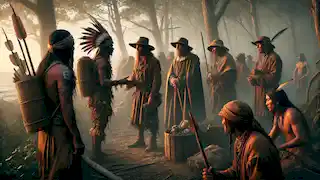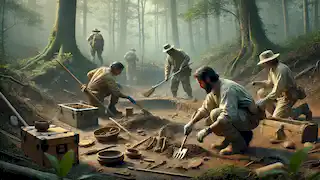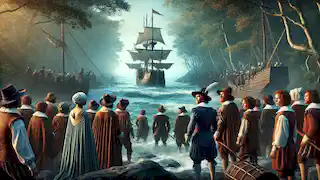Introduction
In the annals of American history, few mysteries have captivated the imagination as thoroughly as the disappearance of the Roanoke Colony. A fledgling English settlement established in 1587, Roanoke Island became the site of one of the greatest unsolved mysteries in North America. What happened to the more than one hundred men, women, and children who vanished without a trace? Why was the word "CROATOAN" found etched into a wooden post? Was it a sign of survival, a message, or something more sinister? This is the story of the Lost City of Roanoke, a tale of hope, hardship, and the enduring enigma that continues to baffle historians.
The Dream of the New World
In the year 1587, an English fleet, led by Governor John White, arrived at Roanoke Island, off the coast of what would become North Carolina. After years of planning and perilous journeys across the Atlantic, these settlers sought to establish a permanent English presence in the New World. Among them were men hardened by years of exploration, women hopeful for a new beginning, and children eager to grow up in a land of boundless promise.
The settlement of Roanoke was part of a grander vision, one sponsored by Sir Walter Raleigh, who believed that England’s future lay in the fertile lands across the ocean. A haven from the religious and political upheaval gripping Europe, the New World was thought to hold vast resources, untold wealth, and endless opportunity. For the settlers of Roanoke, this dream felt within reach.
Yet, from the moment they arrived, they faced challenges. The local Algonquin tribes, led by Chief Wingina, were wary of the newcomers. Though there had been previous contact, relations between the English and the Native peoples were strained by misunderstandings and violent skirmishes. The settlers also found themselves ill-prepared for the harsh realities of life in the wilderness. The humid summers were brutal, and the winter winds biting. Supplies from England were scarce, and the crops they planted struggled in the sandy soil.
As summer turned to fall, the settlers became increasingly aware of their precarious situation. Governor White decided to return to England for reinforcements and more provisions, leaving behind his family, including his newborn granddaughter, Virginia Dare, the first English child born in the New World. He promised the settlers he would return swiftly, but fate had other plans. Unbeknownst to them, a storm was brewing—both in the skies above and in the very heart of England itself.
A World in Turmoil
Back in England, White found his nation in disarray. The political climate was tumultuous, with tensions rising between England and Spain. The Spanish Armada loomed large, preparing to strike at the heart of England in retaliation for years of piracy and privateering against Spanish ships.
Queen Elizabeth I, focused on defending her realm, issued a royal decree: no ships were to leave England’s shores for any reason, not even to resupply the fledgling colony at Roanoke. The settlers, isolated and struggling to survive, would have to wait. Months turned into years as White’s attempts to return to Roanoke were thwarted by war, storms, and a lack of available ships. Each passing day gnawed at him. Were his people surviving? Was his granddaughter safe?
The years wore on, and by 1590, White finally secured passage aboard a ship bound for the New World. But what he found when he arrived at Roanoke would haunt him for the rest of his life.
The Vanishing
When White’s ship finally reached Roanoke Island, the settlement was eerily quiet. The wooden palisade that once surrounded the colony stood intact, but beyond it, there were no signs of life. The houses, once filled with the sounds of families, lay abandoned. Personal belongings were gone, and there were no bodies or signs of struggle. It was as if the settlers had simply walked off into the woods, never to return.
There was, however, one cryptic clue: carved into the post of the palisade was the word “CROATOAN.” White’s heart leapt—this was the name of a nearby island, home to a friendly tribe that the settlers had made contact with before his departure. Perhaps they had moved there for safety. White ordered his crew to set sail for Croatoan Island, but a storm cut their journey short. After battling rough seas for days, the ship was forced to return to England, leaving the fate of the settlers unresolved.

Years passed, and still, no one knew what had happened to the settlers of Roanoke. Rumors and theories abounded. Some believed they had been absorbed into local Native American tribes, intermarrying and adopting their ways of life. Others whispered darker tales—of massacre, starvation, or even supernatural forces at work. But the colony of Roanoke had vanished, and with it, any hope of knowing the truth.
Theories and Legends
The mystery of the Lost Colony has persisted through the centuries, with no definitive answer ever emerging. Historians, archaeologists, and treasure hunters alike have scoured the region for clues, but none have been able to definitively explain what happened to the settlers. What they left behind, however, is a web of theories and legends that continue to intrigue.
One theory suggests that the settlers, in a desperate bid for survival, attempted to integrate with the local Croatan tribe, a small Algonquian group that lived on what is now Hatteras Island. The word “CROATOAN” carved into the palisade could have been a message indicating their destination. In the years that followed, reports from explorers indicated that some Native tribes spoke of light-skinned individuals living among them, which fueled speculation that the colonists had indeed survived by blending into the local population.
Another popular theory posits that the settlers tried to return to England by crafting small boats and sailing up the coast in hopes of finding an English ship. Such a journey would have been perilous, and many could have perished at sea or on the shores of the unfamiliar land to the north. Evidence supporting this theory is scarce, but it remains a plausible explanation for the colony’s disappearance.
Other, more supernatural explanations have also taken root in local folklore. Some believe that the settlers fell victim to an ancient curse laid upon the land by the Native tribes. The carvings, they claim, were not a message but a warning—a sign that the island had been claimed by otherworldly forces. Others speak of ghostly apparitions seen near the shores of Roanoke Island, eerie figures that vanish into the mists just as the colonists themselves did.
The most tantalizing piece of evidence is a series of stones known as the “Dare Stones.” Discovered in the early 20th century, these stones bear inscriptions purportedly written by Eleanor Dare, John White’s daughter. The messages on the stones recount a harrowing journey in which most of the settlers died, and the survivors eventually merged with Native tribes. However, the authenticity of the stones has been hotly debated, with many historians dismissing them as a hoax.
Into the Wilderness
While the theories and legends continue to swirl, there remains one undeniable fact: life in the Roanoke Colony was fraught with danger. The settlers faced harsh conditions, unfriendly neighbors, and a land that was as unforgiving as it was beautiful. It is entirely possible that their disappearance was the result of multiple factors, a combination of starvation, disease, and conflict with the Native tribes.
Some scholars suggest that the settlers may have split into smaller groups in an attempt to find more hospitable land. These groups could have moved inland, blending in with different tribes as they went. Over time, their descendants may have lost all ties to their English origins, becoming fully integrated into the Native culture.
Recent archaeological discoveries have lent some credence to this theory. On Hatteras Island, artifacts such as English coins, weapons, and tools have been uncovered, suggesting that at least some of the settlers made their way there. Additionally, genetic studies of some Native American populations in the area have shown traces of European ancestry dating back to the colonial period.

Despite these tantalizing clues, no conclusive evidence has yet emerged to solve the mystery of Roanoke. The island, now a tranquil historical site, stands as a reminder of both the promise and peril of the New World.
The Legacy of Roanoke
Though the Lost Colony of Roanoke may never yield its secrets, its legacy continues to resonate in American culture. The story of the vanished settlers is one of resilience, hope, and the indomitable human spirit in the face of adversity. It serves as a reminder of the risks early explorers and colonists faced as they ventured into unknown lands.
Roanoke has also become a symbol of the mysteries that lie at the heart of American history. The nation, built on exploration, expansion, and the blending of diverse cultures, finds in Roanoke a microcosm of its own story—a people striving to forge a new identity in a land full of promise but fraught with peril.
The mystery of Roanoke continues to inspire writers, filmmakers, and artists, who draw on its themes of disappearance, survival, and the clash of cultures. The legend of the Lost Colony remains a potent symbol of the unknown, a question mark at the beginning of America’s long and complicated history.
The Endless Search
Even today, the search for answers continues. Archaeologists, historians, and even amateur sleuths are drawn to Roanoke’s shores, hoping to uncover some new piece of the puzzle. Every summer,
expeditions set out to comb the coastline, the nearby islands, and the waters of the Outer Banks in search of artifacts, human remains, or any clue that might reveal what happened to the settlers.
Some believe that the answer may lie not in the ground, but in the stories passed down through generations of Native American tribes. Oral traditions among the Croatan and other Algonquian-speaking peoples could hold vital clues to the fate of the colonists. However, time has a way of erasing memories, and the stories that survive are often shrouded in myth.
There is also a growing recognition that the mystery of Roanoke may never be fully solved. The settlers’ fate is likely the result of a confluence of events, and the passage of more than four centuries has made it increasingly difficult to distinguish fact from fiction.
But in many ways, the mystery of Roanoke is part of its enduring appeal. The questions it raises—about survival, community, and the intersection of cultures—are universal. As long as those questions remain unanswered, the Lost Colony will continue to capture the imagination of those who seek to uncover the truth.

Conclusion: A Mystery for the Ages
The Lost Colony of Roanoke is one of history’s most enduring mysteries. It speaks to the fragility of life in the face of nature’s indifference, the complexities of human relationships, and the sheer unpredictability of history. Though the settlers may be gone, their story lives on, a puzzle that has fascinated generations and will continue to do so for centuries to come.
Perhaps the answer to what happened lies buried beneath the shifting sands of the Outer Banks, or perhaps it has been lost to time altogether. What remains, however, is the haunting legacy of a colony that dared to dream of a new life and vanished without a trace. The tale of Roanoke is not just a story of loss; it is also a story of perseverance, mystery, and the human spirit’s unyielding desire to explore the unknown.
Though we may never know the full story of what happened to the Lost Colony, its impact on American history is undeniable. Roanoke continues to stand as a testament to the early days of exploration, a symbol of the courage it took to venture into the unknown, and a reminder that some mysteries may never be solved.


















